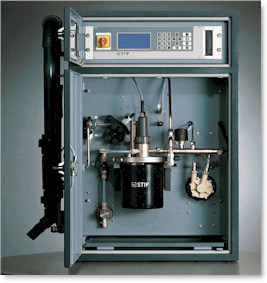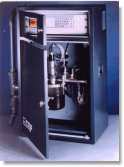Process Control Case Study Summary
On-Line Monitoring for Process Control - draft report from experience at the Los Angele's Glendale WWT, R Iranpour, D BianchiAbstract: This report is a continuation of studies into BOD instruments as a replacement for the BOD-5 measurement as it is too slow for process control. A much faster measurement is needed for operators to respond to shock loadings of organic wastes or toxic chemical discharges. The present study is reported as highly encouraging and indicates that this technology is likely to be a reliable method for nearly instantaneous BOD monitoring for plant process applications.
|
  |
|
|
|
On-line BOD measurement - an important parameter for control at a WWTP, M TeutscherAbstract: A BOD measurement is common for the evaluation of the incoming load and success of waste water treatment plants (WWTP). While the standard BOD5 takes five days to give a result, an on-line BOD analyzer giving results in 3 minutes is described. A short introduction in the wide application of this rapid BOD analysis in municipal and industrial waste water treatment is given. Finally one example of application for automatic control of the biological process of nitrification and DE-nitrification on a municipal WWTP is described in detail.
|
  |
|
|
|
The Management & Sizing of a WWTP (special reference to the local wine industry) - M ChioettoSummary: In Northern Italy a waste water treatment plant is in operation which besides treating the waste water originating
from the sewer from the nearby town, also processes more specific water flows coming from a local winery. When the treatment plant was built, at the beginning of the 80's, it was established as joint project - that is for both municipal and industrial uses. The reasons that led up to this decision are the following: - the polluted load relative to plant discharge from the industrial source was almost completely composed of organic matter of vegetal origin (mostly alcohol and sugar) and was therefore compatible with the public municipal waste discharge. The site of the plant, near the town, made it possible to adopt the same technological solutions for the various discharges of the entire area. |
  |
|
|
|
Multiple Wastewater Parameters
|
  |
|
|
|
Automated nitrification control using in-situ ammonia monitoring, B Cabibel United WaterSummary: To better control the nitrification process at United Water's South Shore WWTP, and the associated operation costs, MMSD and United Water launched a Research & Development project to study and apply the automation of the ammonia removal.
The key component for a reliable process control is to retrieve ammonia concentration analysis on a regular basis during the day in the process control logic. This control logic will then adjust the operation of the aeration basins to keep ammonia concentration in the acceptable range. To perform this ammonia analysis, United Water decided to evaluate different ammonia online analyzers, among them, the Isco-STIP Buoy NH4. Tested during 2 months, the Isco-STIP Buoy NH4 online analyzer gave entire satisfaction to United Water: Installation; mounted and calibrated in only 1 day (compare to up to 1 month for other technologies) |
|
|
|
|
Monitoring & Control for Cost Effective Nutrient Removal or Addition in Waste-Water Process; M Pearce, C Genner CIWEM Conf EdinburghAbstract: On line control of nutrient removal in biological processes, and addition of Phosphorous ad Nitrogen to nutrient deficient biosystems, up to now, have not found widespread application. The reasons for this were lack of reliable "In-Situ" instrumentation together with process variants and physical structures which did not lend themselves easily to dynamic control. The advent of batch and semi batch biological processes, together with recent instrument advances, has potentially changed this. These changes have now enabled an Ammonia measurement system to be installed and test within a digested liquor treatment plant, operating in a semi draw and fill mode. This paper gives details of both Ammonia-N and or the phosphate in situ measurement devices, and describes the practical implementation of such devices on real plants. Effects on effluent quality control and treatment costs are considered. |
|
|
|
|
A New Technology for Continuous In-Situ Monitoring of Nutrient Levels of Ammonia & Nitrate to Meet NPDES Requirements Eugene Sorkin Facilities Engineer Narragansett Bay CommissionAbstract: Current control strategies for optimization of the nitrification and DE-nitrification process of BNR plants and other WWTP's are often limited by the availability of laboratory data. This paper will present the use of a new technology based on the use of the Isco/Stip In-situ process buoy used for the continuous measurement of Ammonium and or Nitrate. Continuous monitoring of ammonia may be used to optimize the aeration process. Inadequate air can result in poor ammonia to nitrate conversion. which can result in ammonia surges at the effluent discharge. An ammonia buoy was installed for evaluation, at a wastewater treatment plant with the Narrangansett Bay Commission in Providence Rhode Island. Data will be presented which will show the relative correlation of the Isco/Stip buoys as compared to laboratory standard method 4500-NH3A. In conclusion treatment plant performance will improve and costs of operation will decrease when on actual conditions. The rate of leaning and depth of understanding of the wastewater treatment process by all involved in management and lower discharge levels of nutrient to meet NPDES requirements. |
|
|
|
|
Strategies to optimize nitrate removal in upstream DE-nitrification stages, J LondongAbstract: • Control of the recycle rate on nitrate levels in the outlet of the DE-nitrification zone • Control via redox potential • Control through adjustment of recycle nitrate levels according to the BOD-M3 that enters the treatment stage It was found that if a stable upstream DE-nitrification zone is required then this could be achieved through controlling the recycle of nitrate based on BOD demand. If this cannot be achieved at the inlet, carbon must be added as a function of DE-nitrification requirements. Sucha control system can be based on measurement of BOD at the inlet and measurement of nitrate at the outlet of the aeration tank. |
|
|
|
|
A Low Capital Cost Option For Improved Nitrogen Removal Using Natural Zeolites Keith Barr,
|
|
|
|
|
Advanced Optimization of Biological Nutrient Removal Plants Using Feedforward, Feedback Control-Case StudiesAbstract: This paper deals with specific examples of feedforward and feedback control of nitrogen an/or phosphorous removal plants using on line analysis and automated control. The plants had previously been optimized using traditional techniques utilizing lab samples and extensive experience. The data presented therefore indicates the potential, then quantifies the gains achievable when the restrictions of dealing with averages is removed. The improvement shown is a direct result of the increase in data available using on line analysis in conjunction with appropriate control algorithms.
|
|
|
|
|

